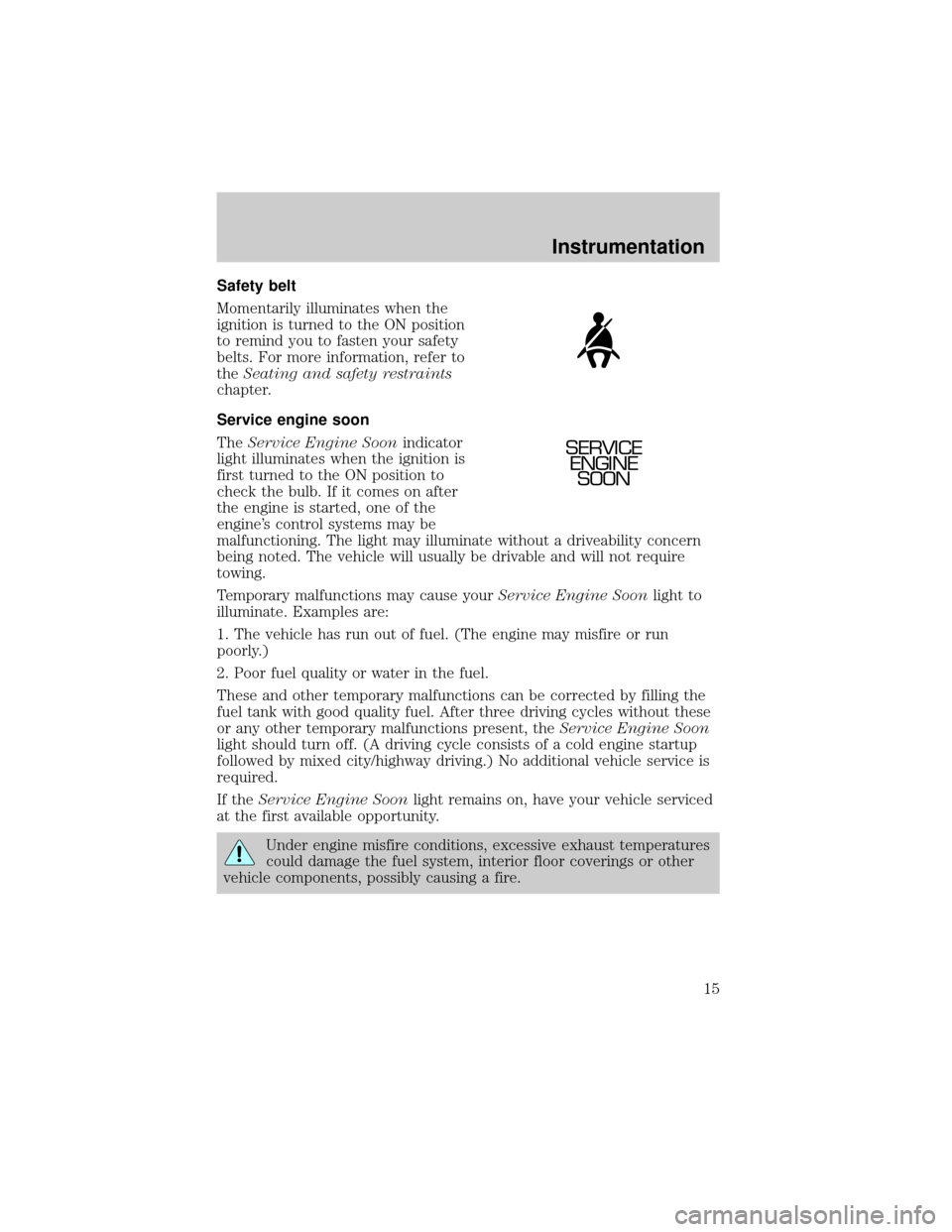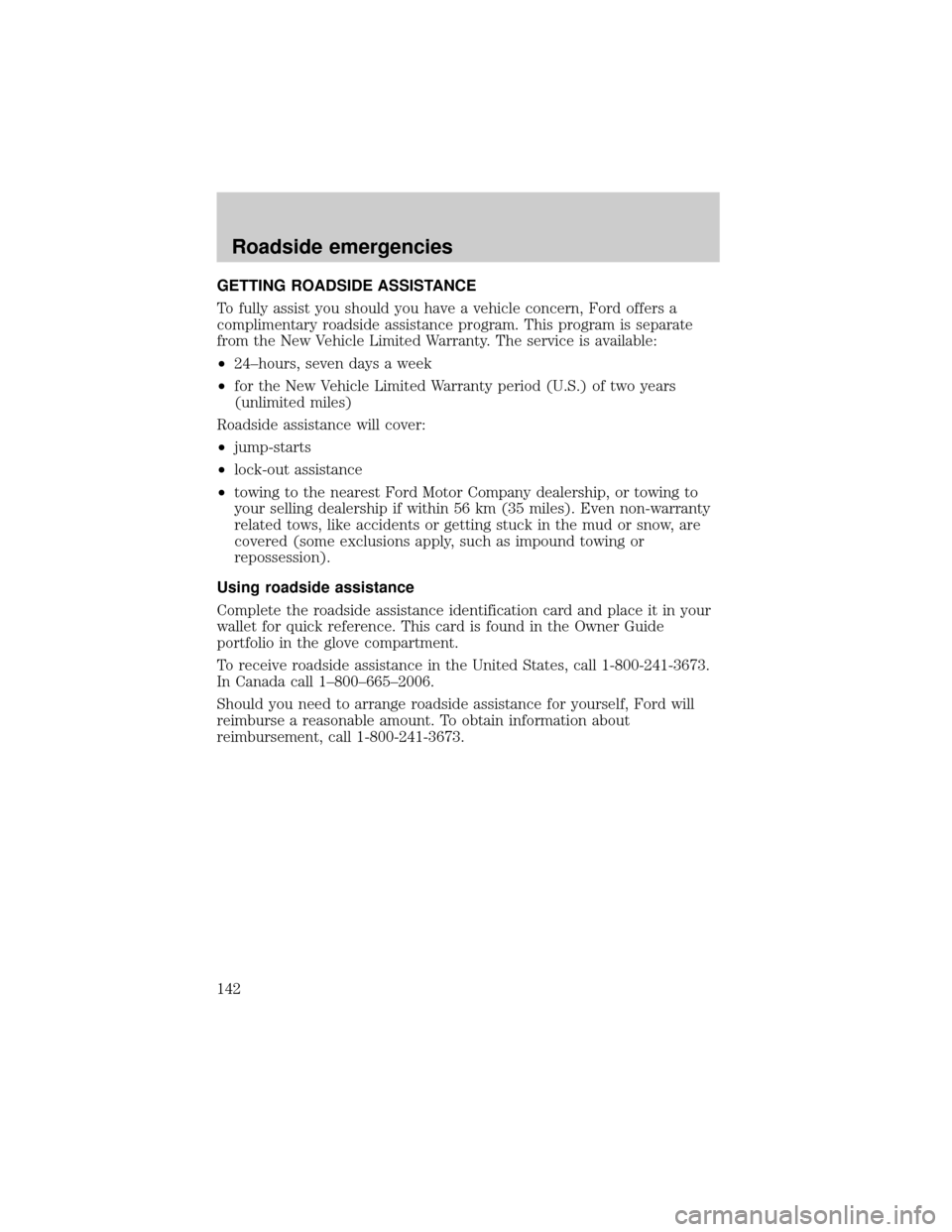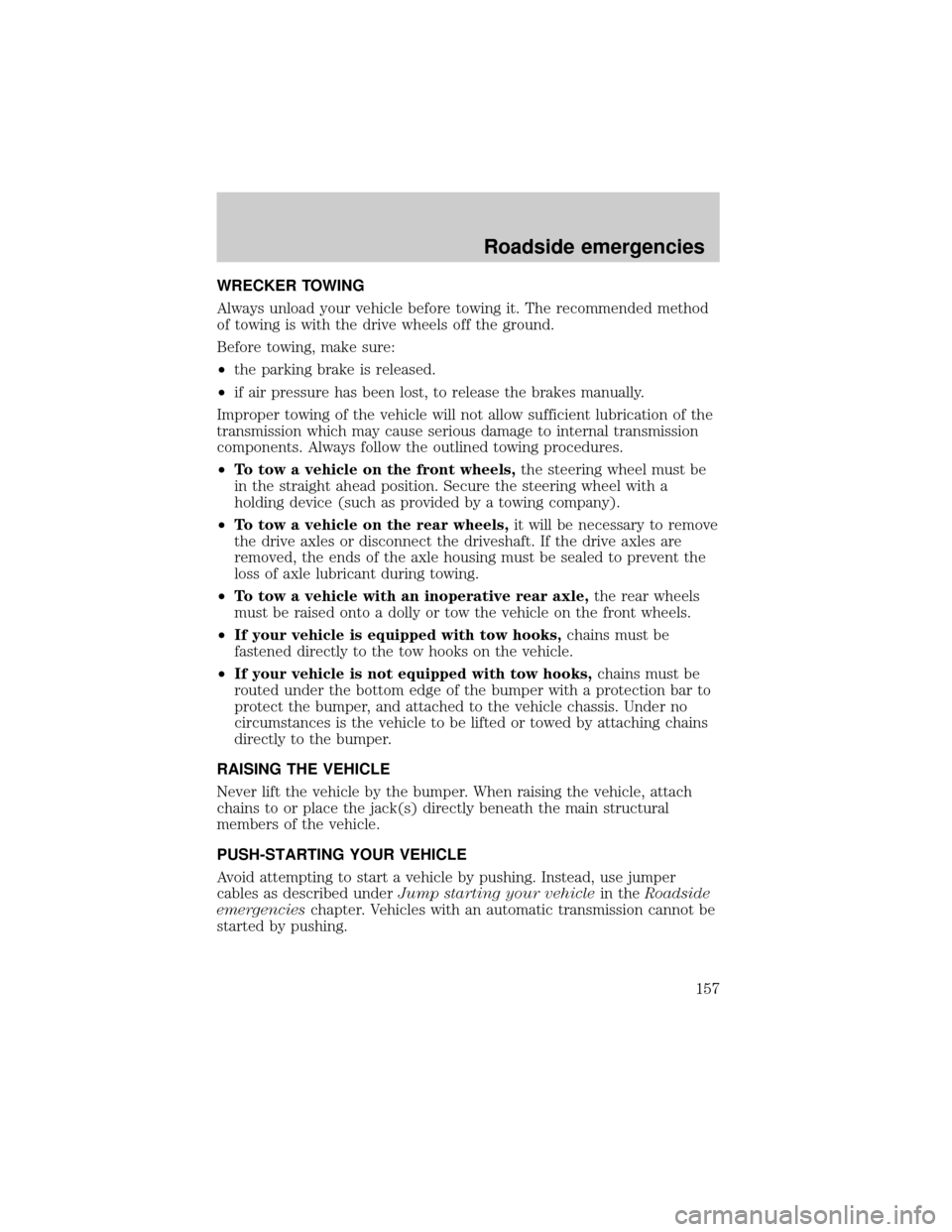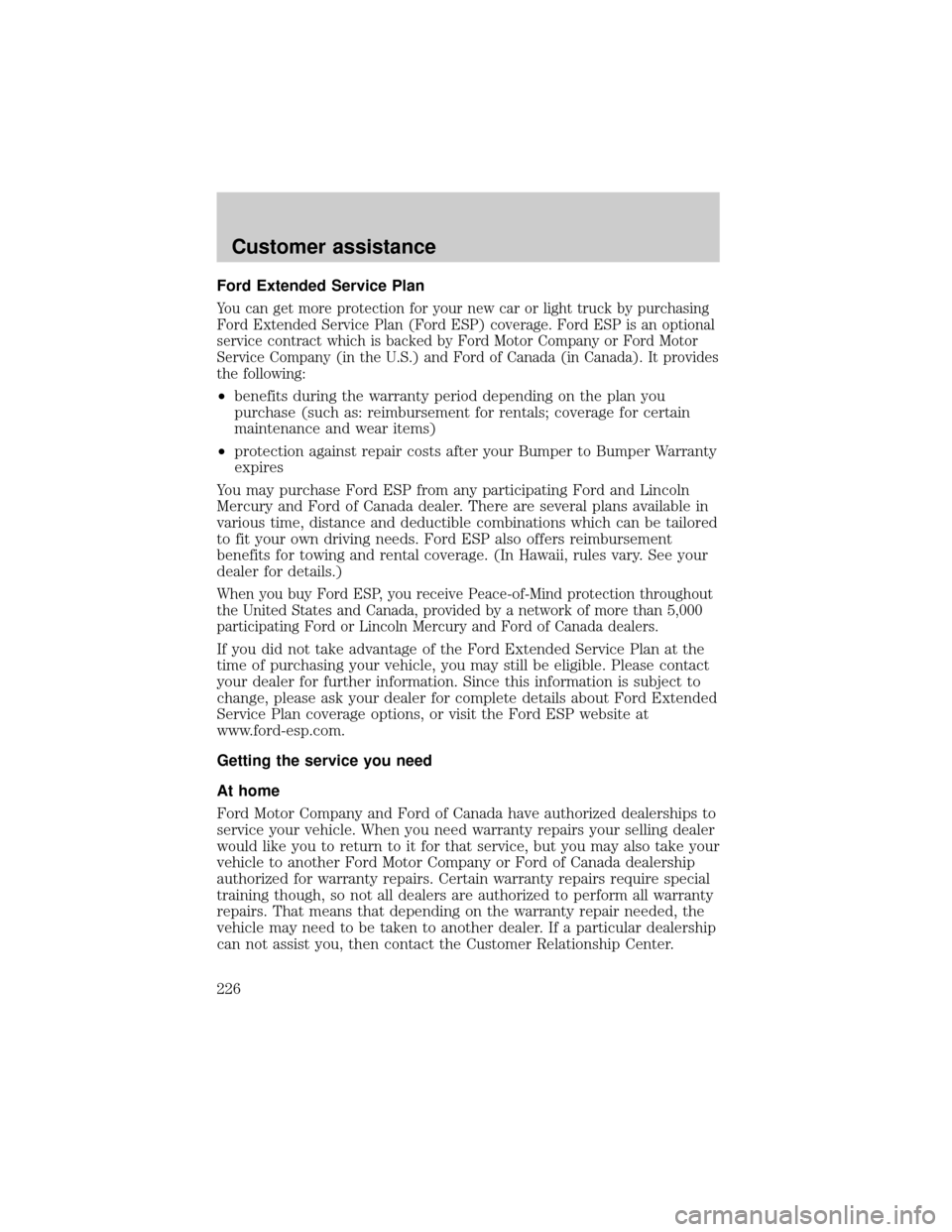2001 FORD F650 towing
[x] Cancel search: towingPage 15 of 240

Safety belt
Momentarily illuminates when the
ignition is turned to the ON position
to remind you to fasten your safety
belts. For more information, refer to
theSeating and safety restraints
chapter.
Service engine soon
TheService Engine Soonindicator
light illuminates when the ignition is
first turned to the ON position to
check the bulb. If it comes on after
the engine is started, one of the
engine's control systems may be
malfunctioning. The light may illuminate without a driveability concern
being noted. The vehicle will usually be drivable and will not require
towing.
Temporary malfunctions may cause yourService Engine Soonlight to
illuminate. Examples are:
1. The vehicle has run out of fuel. (The engine may misfire or run
poorly.)
2. Poor fuel quality or water in the fuel.
These and other temporary malfunctions can be corrected by filling the
fuel tank with good quality fuel. After three driving cycles without these
or any other temporary malfunctions present, theService Engine Soon
light should turn off. (A driving cycle consists of a cold engine startup
followed by mixed city/highway driving.) No additional vehicle service is
required.
If theService Engine Soonlight remains on, have your vehicle serviced
at the first available opportunity.
Under engine misfire conditions, excessive exhaust temperatures
could damage the fuel system, interior floor coverings or other
vehicle components, possibly causing a fire.
SERVICE
ENGINE
SOON
Instrumentation
15
Page 142 of 240

GETTING ROADSIDE ASSISTANCE
To fully assist you should you have a vehicle concern, Ford offers a
complimentary roadside assistance program. This program is separate
from the New Vehicle Limited Warranty. The service is available:
²24±hours, seven days a week
²for the New Vehicle Limited Warranty period (U.S.) of two years
(unlimited miles)
Roadside assistance will cover:
²jump-starts
²lock-out assistance
²towing to the nearest Ford Motor Company dealership, or towing to
your selling dealership if within 56 km (35 miles). Even non-warranty
related tows, like accidents or getting stuck in the mud or snow, are
covered (some exclusions apply, such as impound towing or
repossession).
Using roadside assistance
Complete the roadside assistance identification card and place it in your
wallet for quick reference. This card is found in the Owner Guide
portfolio in the glove compartment.
To receive roadside assistance in the United States, call 1-800-241-3673.
In Canada call 1±800±665±2006.
Should you need to arrange roadside assistance for yourself, Ford will
reimburse a reasonable amount. To obtain information about
reimbursement, call 1-800-241-3673.
Roadside emergencies
142
Page 157 of 240

WRECKER TOWING
Always unload your vehicle before towing it. The recommended method
of towing is with the drive wheels off the ground.
Before towing, make sure:
²the parking brake is released.
²if air pressure has been lost, to release the brakes manually.
Improper towing of the vehicle will not allow sufficient lubrication of the
transmission which may cause serious damage to internal transmission
components. Always follow the outlined towing procedures.
²To tow a vehicle on the front wheels,the steering wheel must be
in the straight ahead position. Secure the steering wheel with a
holding device (such as provided by a towing company).
²To tow a vehicle on the rear wheels,it will be necessary to remove
the drive axles or disconnect the driveshaft. If the drive axles are
removed, the ends of the axle housing must be sealed to prevent the
loss of axle lubricant during towing.
²To tow a vehicle with an inoperative rear axle,the rear wheels
must be raised onto a dolly or tow the vehicle on the front wheels.
²If your vehicle is equipped with tow hooks,chains must be
fastened directly to the tow hooks on the vehicle.
²If your vehicle is not equipped with tow hooks,chains must be
routed under the bottom edge of the bumper with a protection bar to
protect the bumper, and attached to the vehicle chassis. Under no
circumstances is the vehicle to be lifted or towed by attaching chains
directly to the bumper.
RAISING THE VEHICLE
Never lift the vehicle by the bumper. When raising the vehicle, attach
chains to or place the jack(s) directly beneath the main structural
members of the vehicle.
PUSH-STARTING YOUR VEHICLE
Avoid attempting to start a vehicle by pushing. Instead, use jumper
cables as described underJump starting your vehiclein theRoadside
emergencieschapter. Vehicles with an automatic transmission cannot be
started by pushing.
Roadside emergencies
157
Page 226 of 240

Ford Extended Service Plan
You can get more protection for your new car or light truck by purchasing
Ford Extended Service Plan (Ford ESP) coverage. Ford ESP is an optional
service contract which is backed by Ford Motor Company or Ford Motor
Service Company (in the U.S.) and Ford of Canada (in Canada). It provides
the following:
²benefits during the warranty period depending on the plan you
purchase (such as: reimbursement for rentals; coverage for certain
maintenance and wear items)
²protection against repair costs after your Bumper to Bumper Warranty
expires
You may purchase Ford ESP from any participating Ford and Lincoln
Mercury and Ford of Canada dealer. There are several plans available in
various time, distance and deductible combinations which can be tailored
to fit your own driving needs. Ford ESP also offers reimbursement
benefits for towing and rental coverage. (In Hawaii, rules vary. See your
dealer for details.)
When you buy Ford ESP, you receive Peace-of-Mind protection throughout
the United States and Canada, provided by a network of more than 5,000
participating Ford or Lincoln Mercury and Ford of Canada dealers.
If you did not take advantage of the Ford Extended Service Plan at the
time of purchasing your vehicle, you may still be eligible. Please contact
your dealer for further information. Since this information is subject to
change, please ask your dealer for complete details about Ford Extended
Service Plan coverage options, or visit the Ford ESP website at
www.ford-esp.com.
Getting the service you need
At home
Ford Motor Company and Ford of Canada have authorized dealerships to
service your vehicle. When you need warranty repairs your selling dealer
would like you to return to it for that service, but you may also take your
vehicle to another Ford Motor Company or Ford of Canada dealership
authorized for warranty repairs. Certain warranty repairs require special
training though, so not all dealers are authorized to perform all warranty
repairs. That means that depending on the warranty repair needed, the
vehicle may need to be taken to another dealer. If a particular dealership
can not assist you, then contact the Customer Relationship Center.
Customer assistance
226
Page 240 of 240

panic alarm ...............................79
replacement/additional
transmitters ...............................80
replacing the batteries .............81
S
Safety belts (see Safety
restraints) ..............................87±89
Safety defects, reporting ..........236
Safety restraints ....................87±89
belt minder ...............................92
cleaning the safety belts ..95, 199
extension assembly ..................91
for adults .............................88±89
for children ...............................96
lap belt ......................................90
warning light and
chime ....................... 15±16, 91±92
Safety seats for children ............97
Seat belts (see Safety
restraints) ....................................87
Seats ............................................82
child safety seats ......................97
Servicing your vehicle ..............211
Speed control ..............................66
Speedometer ...............................18
Starting your vehicle ................102
jump starting ..........................157
preparing to start your
vehicle .....................................102
T
Tachometer .................................19
Tires
checking the pressure ............183Towing
wrecker ....................................157
Transmission
fluid, checking and adding
(automatic) .............................169
fluid, checking and adding
(manual) .................................169
manual operation ....................126
Trip odometer .............................19
Turn signal ............................12, 65
V
Vehicle Identification Number
(VIN) ..........................................205
Vehicle loading ..........................140
W
Warning chimes .............10, 16, 112
Warning lights (see Lights) .......10
Washer fluid ..............................165
reservoir ..................................165
Water, Driving through .............140
Wheels .......................................179
Windows
power .........................................75
Windshield washer fluid and
wipers
checking and cleaning ............178
operation ...................................65
replacing wiper blades ...........178
Wrecker towing .........................157
Index
240